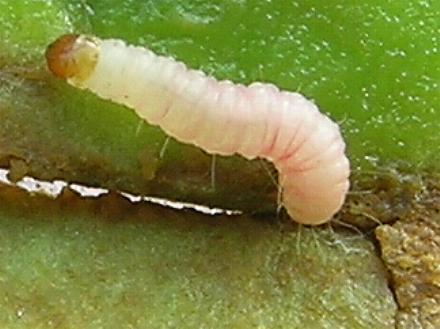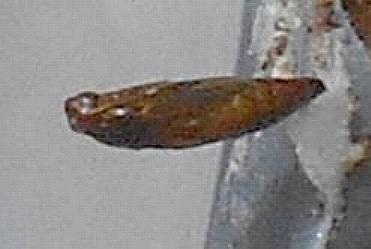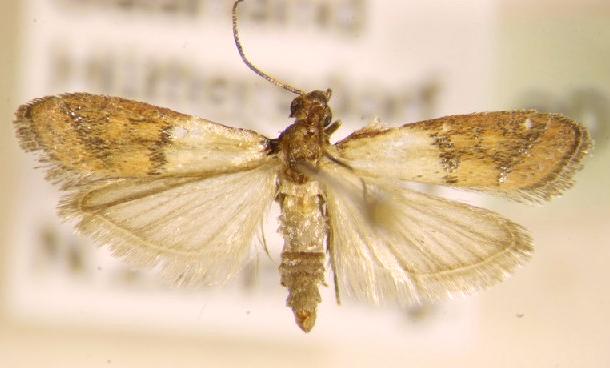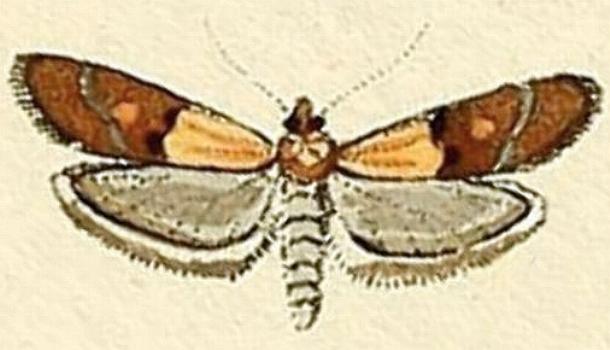
| Indian Meal Moth (one synonym : Tinea zeae Fitch, 1856) PHYCITINI, PHYCITINAE, PYRALIDAE, PYRALOIDEA | (donherbisonevans@yahoo.com) and Stella Crossley |


| Indian Meal Moth (one synonym : Tinea zeae Fitch, 1856) PHYCITINI, PHYCITINAE, PYRALIDAE, PYRALOIDEA | (donherbisonevans@yahoo.com) and Stella Crossley |

This Caterpillar is white with a brown head, and sparse long white hairs. It is a pest both in Australia and overseas, of any stored foodstuff, for example:
As it infests these foodstuffs, it pollutes them with an unpleasant odour, and intersperses them with a web of silk.
When one caterpillar encounters another, they each produce a small amount of brown liquid from the mouth, and this causes the caterpillars to walk apart. This appears to be a mechanism that prevents overcrowding of the caterpillars. Unfortunately for the caterpillars, this mandibular secretion also attracts parasitoid wasps.

The caterpillar typically walks several metres from its foodstuff to pupate in a sparse silk cocoon. The pupa is brown with prominent bulges where the eyes develop.

The adult is brown, with a pale basal area on each forewing demarked by a dark line. The hindwings are plain off-white. The moths have a wingspan of about 1.5 cms.

The eggs are white and approximately spherical, with a diameter of about 0.3 mm. The eggs are laid in loose clusters of several dozen especially in crannies and cracks. A female can lay a total of several hundred eggs. The adult females are attracted to lay eggs on larval foodstuffs, especiall those contaminated by wandering fifth instar larvae.
The adults use ultrasonic sounds (~80 Khz) in their courtship behaviour. They also use pheromones (specific sex-attractant substances) the nature of which have been determined. Domestic pheromone traps can be purchased to control the moths. The authors found that these can have an embarrassing effect if used in the home, as some pheromone condenses on clothing. Then when one then walks around a supermarket (where inevitably there will be some of these moths present), rather embarrassingly: they cluster and flutter around one's body.
Attempts have also been made to control the pest using :

This species originated in Europe, but now occurs world-wide, for example:
and over the whole of Australia (having been introduced by unfortunate accident)
including:
Further reading :
Ian F.B. Common
Jacob Hübner,
Peter B. McQuillan, Jan A. Forrest, David Keane, & Roger Grund,
M.S. Mossadegh,
J.K. Waage,
(updated 2 February 2010, 5 August 2018, 13 April 2021)
Moths of Australia,
Melbourne University Press, 1990, pp. 57, 68, 350.
Sammlung Europäischer Schmetterlinge,
Lepidoptera 8 (1813), Plate 45 (Tinea 5), fig. 310.
Caterpillars, moths, and their plants of Southern Australia,
Butterfly Conservation South Australia Inc., Adelaide (2019), p. 81.
Inter- and intra-specific effects of the mandibular gland secretion of
larvae of the Indian-meal moth, Plodia interpunctella,
Physiological Entomology,
Volume 5 (1980), pp. 165-173.
Arrestment responses of the parasitoid, Nemeritis canescens,
to a contact chemical produced by its host, Plodia interpunctella,
Physiological Entomology,
Volume 3 (1978), pp. 135-146.

caterpillar

butterflies

Lepidoptera

moths

caterpillar